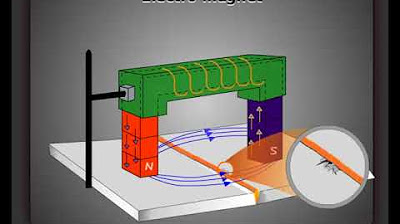radiography testing
Summary
TLDRThis video introduces radiography testing, a technique used to detect internal flaws in metals and other materials, including well works. It explains how short-wavelength x-rays and gamma rays from sources like x-ray tubes or cobalt-60 penetrate materials to reveal defects. Radiography is effective for thin sections and a variety of materials, with film used to record results. However, it has limitations, such as being unsuitable for detecting surface flaws or indicating defect depth. A major drawback is the health hazards posed by radiation exposure during the process.
Takeaways
- 🔍 Radiography testing is used to detect internal flaws in ferrous, non-ferrous metals, and other materials.
- 📏 It is also utilized to inspect weld works in components.
- 🔬 Short wavelength radiation, such as X-rays and gamma rays, is employed to perform radiography tests.
- 💡 Gamma rays, particularly from isotopes like cobalt-60, can penetrate thicker materials than X-rays.
- 🎞️ The specimen is placed between the radiation source and a film, which records the results of the test.
- 🧫 The film is made of polyester with a silver salt emulsion coating to improve radiation absorption.
- ⚠️ Radiography is effective for identifying flaws in thin sections and any type of material.
- 🚫 However, it is not suitable for detecting surface defects or determining the depth of a flaw.
- 💊 A major disadvantage is that radiography testing poses health hazards due to radiation exposure.
- 🔗 Protective coatings are applied to the film to safeguard it from external damage.
Q & A
What is radiography testing used for in the context of weld works?
-Radiography testing is used to detect internal flaws in ferrous, non-ferrous metals, and other materials, including weld works.
What types of radiation are used in radiography testing?
-Radiography testing uses short-wavelength radiations such as x-rays and gamma rays.
What are the sources of gamma rays used in radiography testing?
-Gamma rays used in radiography testing come from radioisotopes such as cobalt-60.
How does radiography testing work in detecting flaws in a specimen?
-In radiography testing, the specimen is placed between the radiation source and a film. The film records the radiation absorption, with dark areas indicating flaws where more radiation has passed through.
What materials are commonly tested using radiography?
-Radiography can be used to test ferrous and non-ferrous metals and various other materials.
What is the advantage of using gamma rays over x-rays in radiography testing?
-Gamma rays, especially from sources like cobalt-60, can penetrate thicker materials than x-rays, making them more effective for inspecting thicker specimens.
What are the main components of the film used in radiography testing?
-The film consists of a polyester base, protective coating, and an emulsion coating made of silver salts in gelatin. The emulsion enhances radiation absorption, and the protective coating safeguards the film.
What are the advantages of radiography testing?
-Radiography testing is effective for identifying flaws in thin sections and can be used on a variety of materials.
What are the disadvantages of radiography testing?
-Radiography testing is not suitable for detecting surface defects, it cannot determine the depth of a flaw beneath the surface, and it poses health hazards due to radiation exposure.
Why is radiography testing not suitable for detecting surface defects?
-Radiography is designed to detect internal flaws and is not effective at detecting surface defects, which require different testing methods.
Outlines

This section is available to paid users only. Please upgrade to access this part.
Upgrade NowMindmap

This section is available to paid users only. Please upgrade to access this part.
Upgrade NowKeywords

This section is available to paid users only. Please upgrade to access this part.
Upgrade NowHighlights

This section is available to paid users only. Please upgrade to access this part.
Upgrade NowTranscripts

This section is available to paid users only. Please upgrade to access this part.
Upgrade Now5.0 / 5 (0 votes)





